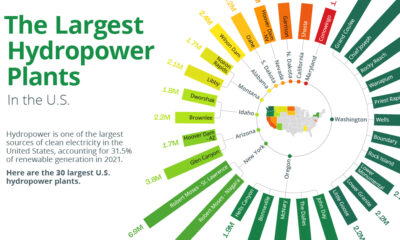Clean Energy
The 2022 Energy Crisis: A Tipping Point for Clean Energy
The following content is sponsored by the National Public Utilities Council

The 2022 Energy Crisis: A Tipping Point for Clean Energy
The global energy crisis of 2022 sent shockwaves in the energy markets.
The crisis acted as a double-edged sword—on one hand, consumers felt the pinch of rising energy prices, but on the other hand, it became a turning point for clean energy, spurring action from governments to cut dependence on fossil fuels.
This infographic from the National Public Utilities Council explores how the energy crisis accelerated the growth of clean energy and nuclear power.
Shockwaves From the Energy Crisis
Although the consequences of the crisis were felt in 2022, its roots go back to 2020 when energy demand dipped during the pandemic.
Following the unprecedented fall in demand, energy markets tightened in 2021 as the global economy rebounded to grow at the fastest pace since 1973. Russia’s invasion of Ukraine escalated the situation, creating a full-scale energy crisis.
As a result, energy prices soared to their highest levels in decades, resulting in rampant inflation worldwide. This highlighted how many nations remained dependent on fossil fuels for energy, in turn creating a tipping point for clean energy.
Clean Energy Turns the Corner
Countries including the United States, the UK, and many EU member states have supercharged clean energy investment over the last two years, partly in response to the energy crisis.
Here’s how global government spending for clean energy has grown since July 2021, as tracked by the IEA:
- $380 billion as of July 2021
- $470 billion as of October 2021
- $714 billion as of March 2022
- $1,215 billion as of November 2022
European countries deployed funding for energy efficiency and low-carbon power generation (through REPowerEU) in response to natural gas supply disruptions from Russia. In August of 2022, the U.S. signed the Inflation Reduction Act into law, providing over $390 billion in clean energy and climate funding.
Consequently, clean energy technologies are growing at an unprecedented rate. The IEA forecasts that global renewable electricity capacity additions from 2022 to 2027 (2,383 GW) will nearly equal all the renewable capacity added between 2001 and 2021 (2,409 GW).
Nuclear Turnaround
Besides renewables, nuclear power has seen a resurgence as governments look for a reliable energy source to replace fossil generation.
Here’s a look at the top 10 countries by the number of prospective nuclear reactors based on the Global Nuclear Power Tracker. This includes announced, pre-construction, and under-construction reactors.
| Country | Number of Prospective Reactors | % of Global Total |
|---|---|---|
| China 🇨🇳 | 103 | 41% |
| India 🇮🇳 | 32 | 13% |
| Russia 🇷🇺 | 30 | 12% |
| Turkey 🇹🇷 | 12 | 5% |
| U.S. 🇺🇸 | 12 | 5% |
| Romania 🇷🇴 | 8 | 3% |
| Poland 🇵🇱 | 6 | 2% |
| UK 🇬🇧 | 6 | 2% |
| South Korea 🇰🇷 | 5 | 2% |
| Bulgaria 🇧🇬 | 4 | 2% |
Besides the countries building and planning reactors, others have reversed their plans to phase out nuclear power:
- Germany extended the lifetime of three plants that were set to shut down in 2022.
- France reversed course to reduce reliance on nuclear, with a plan to build six new reactors.
- Japan accelerated the restarts of nine reactors by winter 2022 and a further seven by summer 2023.
The impact of this accelerated clean energy deployment is already evident.
In 2022, the growth of clean energy technologies helped avoid 550 million tonnes of CO2 emissions, according to the IEA. On the other hand, a decline in nuclear power generation led to an additional 55 million tonnes in CO2 emissions, highlighting the importance of nuclear in reducing emissions.
Clean Energy
Visualized: The Four Benefits of Small Modular Reactors
What advantages do small modular reactors offer compared to their traditional counterparts?

Visualized: The Four Benefits of Small Modular Reactors
Nuclear power has a crucial role to play on the path to net zero. Traditional nuclear plants, however, can be costly, resource-intensive, and take up to 12 years to come online.
Small modular reactors (SMR) offer a possible solution.
Created in partnership with the National Public Utilities Council, this infographic explores some of the benefits SMRs can offer their traditional counterparts. Let’s dive in.
The Four Key Benefits of SMRs, Explained
An SMR is a compact nuclear reactor that is typically less than 300 megawatts electric (MWe) in capacity and manufactured in modular units.
Here are some of the benefits they offer.
#1: Lower Costs
SMRs require a lower upfront capital investment due to their compact size.
SMRs can also match the per-unit electricity costs of traditional reactors due to various economic efficiencies related to their modular design, including design simplification, factory fabrication, and potential for regulatory harmonization.
#2: Quicker Deployment
Traditional nuclear plants can take up to 12 years to become operational. This is primarily due to their site-specific designs and substantial on-site labor involved in construction.
SMRs, on the other hand, are largely manufactured in factories and are location-independent, which minimizes on-site labor and expedites deployment timelines to as little as three years. This means they can be deployed relatively quickly to provide emissions-free electricity to the grid, supporting growing electricity needs.
#3: Siting Flexibility and Land Efficiency
SMRs have greater siting flexibility compared to traditional reactors due to their smaller size and modular design. In addition, they can utilize land more effectively than traditional reactors, yielding a higher output of electrical energy per unit of land area.
| Rolls-Royce SMR, UK (Proposed) | Median-Sized U.S. Nuclear Plant | |
|---|---|---|
| Capacity | 470 MW | 1,000 MW |
| Area Requirement | 10 Acres* | 832 Acres |
| Land/Space Efficiency | 47 MW/Acre | 1.2 MW/Acre |
*Estimated area requirement
Given their flexibility, SMRs are also suitable for installation on decommissioned coal power plant sites, which can support the transition to clean electricity while utilizing existing transmission infrastructure.
#4: Safety
SMRs have simpler designs, use passive cooling systems, and require lower power and operating pressure, making them inherently safer to operate than traditional reactors.
They also have different refueling needs compared to traditional plants, needing refueling every 3–7 years instead of the 1–2 years typical for large plants. This minimizes the transportation and handling of nuclear fuel, mitigating the risk of accidents.
The Road Ahead
As of early 2024, only five SMRs are operating worldwide. But with several other projects under construction and nearly 20 more in advanced stages of development, SMRs hold promise for expanding global emission-free electricity capacity.
With that said, certain obstacles remain for the wide-scale adoption of SMRs in the United States, which was particularly apparent in the 2023 cancellation of the NuScale SMR project.
To fully realize the benefits of SMRs and advance decarbonization efforts, a focus on financial viability, market readiness, and broader utility and public support may be essential.
Learn how the National Public Utilities Council is working toward the future of sustainable electricity.
Clean Energy
The $3 Trillion Clean Energy Investment Gap, Visualized
In this graphic, we explore the $3 trillion clean energy investment gap visualized by sector, according to BloombergNEF data.

The $3 Trillion Clean Energy Investment Gap, Visualized
Global investment in the clean energy transition grew by 17% in 2023, showing resilience despite geopolitical tensions, high interest rates, and inflation.
But was it enough to keep the world on track to hit net zero by 2050?
To answer this question, we compare 2023 clean energy investment by sector with what’s annually needed to reach net zero by 2050, in partnership with the National Public Utilities Council.
The Investment Gap, By Sector
According to BloombergNEF data, annual global investment in the energy transition is at an all-time high. Despite this, only the electrified heat and clean industry sectors are meeting the thresholds necessary to hit net zero by 2050.
| 2023 Investment | Required Annual Investment for Net Zero*, 2024–2030 | Investment Gap | |
|---|---|---|---|
| Electrified transport | $632B | $1,805B | $1,173B |
| Renewable energy | $623B | $1,317B | $694B |
| Electricity grids | $310B | $700B | $390B |
| Electrified heat | $63B | $50B | -$13B |
| Clean industry | $49B | $21B | -$28B |
| Energy storage | $36B | $93B | $57B |
| Nuclear energy | $33B | $284B | $251B |
| Carbon capture and storage (CCS) | $11B | $510B | $499B |
| Hydrogen | $10B | $62B | $52B |
| TOTAL | $1,767B | $4,842B | $3,075B |
*BloombergNEF’s Net-Zero 2050 Scenario
To stay on track for net zero by 2050, the yearly investments in electrified transport, renewable energy, power grids, and energy storage must more than double their current rates for the rest of the decade.
Hydrogen, nuclear, and carbon capture and storage (CCS) have an even steeper hill to climb and must grow 6, 9, and 46 fold, respectively.
The Path Forward
It’s important to note that despite the current annual investment gap of $3T, the clean energy industry continues to exhibit positive trends.
Investment in electrified transport, for instance, surpassed that in renewable energy for the first time in 2023, marking a win for the sector.
Emerging sectors also experienced robust expansion despite being furthest off-target. Investments in hydrogen tripled to $10B, CCS nearly doubled to $11B, and energy storage witnessed a 76% increase to reach $36B in 2023.
These encouraging developments underscore the industry’s potential to drive transformative change and pave the way for a more sustainable and resilient energy landscape in the years ahead.
Learn how the National Public Utilities Council is working toward the future of sustainable electricity.
-

 Electrification1 year ago
Electrification1 year agoVisualized: How the Power Grid Works
-

 Energy Shift9 months ago
Energy Shift9 months agoRanked: The Cheapest Sources of Electricity in the U.S.
-

 Energy Shift1 year ago
Energy Shift1 year agoAnimated: 70 Years of U.S. Electricity Generation by Source
-

 Clean Energy1 year ago
Clean Energy1 year agoBreaking Down Clean Energy Funding in the Inflation Reduction Act
-

 Emissions1 year ago
Emissions1 year agoVisualizing Global Per Capita CO2 Emissions
-

 Clean Energy1 year ago
Clean Energy1 year agoThe 30 Largest U.S. Hydropower Plants
-

 Decarbonization1 year ago
Decarbonization1 year agoThe U.S. Utilities Decarbonization Index
-

 Clean Energy6 months ago
Clean Energy6 months agoBreaking Down the $110 Trillion Cost of the Clean Energy Transition

